Jasmine Hearn Dances Generational History in Memory Fleet
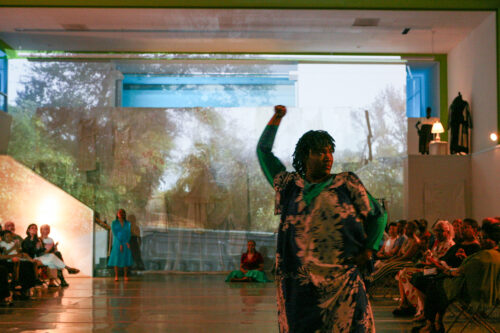
I have been thinking a lot about personal history lately. I have been interested, not so much in genealogy, but the architecture that goes deeper than bone, the family myths that make everyday life extraordinary. When you live in the same community your entire life, you understand that the past, present, and future often exist in tandem.
There have been times I have wandered through my neighborhood and a figure from the faraway past reveals themselves for a brief interaction, and I am left thinking that ghosts are among us in flesh and blood. My grandmother’s lilies bloom every Easter weekend, reminding me that she and my grandfather carved out this space in Near Northside, Houston for me, that I was built from firebrand spirits and a love that I have only now come to comprehend.
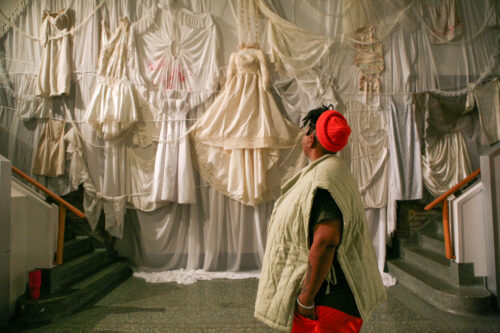
Watching Jasmine Hearn’s stunning, complex, and bold Memory Fleet: A Return to Matr, performed April 6 and 7 at Houston Met Dance and presented and produced by DiverseWorks, I had the impression that I was witnessing a true conjuring of spirits. The Houston Met Dance space was transformed into a living altar of sorts by the artistic team, the highlight of which was a wall of suspended white dresses designed by Lovie Olivia, Myssi Robinson, and Hearn. The installation, a team effort, was created by additional support from Ashley DeHoyos Sauder, Nora Alami, and Areli Navarro Magallón. The blast of lace and brocade suggested both the pain and joy of generations of matriarchs united by blood and matrimony.
Opposite this shrine lived a parachute that was open in half bloom, its sheer size both overwhelming and captivating. Like the wall of dresses, it offered up a canvas for the videography of Myssi Robinson and Hearn, and video design by Robinson. The visual landscape, the sound design of familial narratives, and the movement of Memory Fleet are an homage to the mentors of Hearn’s inspiration and their lived experiences.
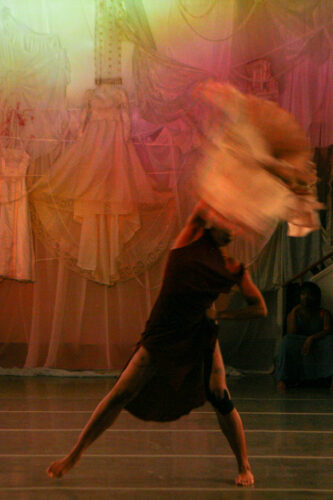
The work opens with Hearn and their ensemble engaging in the choreography of warming the body, an exciting pattering of mark throughs with the eagerness of preparing for a debutante ball, which also happens to a part of Hearn’s family history. When the ensemble dissipates, Hearn enters like a pink plume of smoke, their dancing expansive and clear of intention. The never-ending spirals of their dance evoke a sense of ocean waves and saltwater dreams.
There is a moment in Memory Fleet where Hearn proudly proclaims that they come from their mother, their grandmother, their aunt, their sister. The soundscape by Hearn and Ashley Teamer illuminate the lessons from these Auntie and Matriarch figures, and successfully ground the movement in context, place, and history, their legacy drawn from lands in Houston, Huntsville, Winnie and Beaumont.
This is where the technical abilities of the Houston Met Dance space faltered just a bit. The acoustics of the expansive, cavernous space did not allow for clear rendering of the soundscape, and I would have liked to hear these firsthand accounts with the authority that they deserve. The projections, which illustrated the landscapes of Hearn’s past, might have provided a strong illustration if they had been in a tighter space, but these were minor distractions.
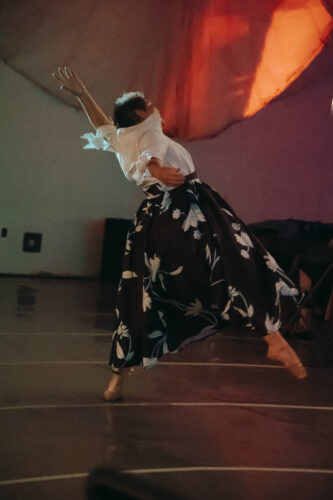
The gathering of six dancers worked well as an ensemble, but not every featured section carried the work’s gravitas and scope of content. Much note must be given to the work of Sandra Organ Solis. She was a revelation at every turn, particularly in her solo of embodied gestures set to Hearn’s poetic word play. Solis danced through the calls of “gathering,” “opening,” “spicing,” “simmering,” “kicking sand off feet,” and “pot stirrer.” Her dancing was succinct yet regal, clear yet full of sinewy life force.
Solis’ duet work with Hearn was also spellbinding, first in a contact practice that each dancer alternately make contact, then shift away while still holding tension across space, and then in a glorious unison section full of rich movement and heartfelt dancing. Solis fully realized Hearn’s ideas of matriarchy, but she also relished in the power of her own artistry, as if to remind the audience that once Diva of Dance, always a Diva of Dance.
Zuri Humphrey was also memorable in an electric solo in robin egg’s blue sequins. This section was contemplative yet dynamic, with Humphrey at times almost possessed at the pelvis. She alternately framed her face and part of her body, inspecting herself in the mirror, a vacillation of sorts between self-criticism and self-love.
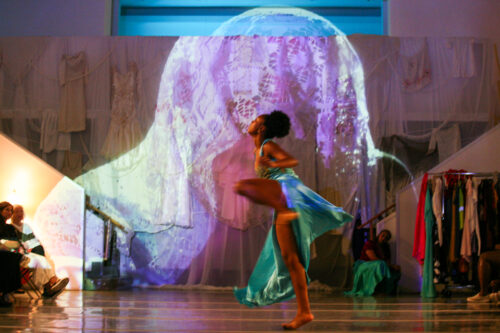
What is so impressive about Memory Fleet: A Return to Matr is Hearn’s demonstration of dance as living archive, and the body as keeper of familial mythology. There is a universality in the specificity of the work. While the Sunday performance that I witnessed seemed like a definitive work, it was clear that there was room for an expansive, continued life elsewhere and with additional oral histories.
There was a spirit of reunion in the audience of Memory Fleet, with everyone gathered to share in a momentous event. The feeling was electric, a communal witnessing of an artist at the height of their powers sharing with complete openness and generosity.
I wonder what other magic Memory Fleet will manifest in other iterations…..
SUPPORT: Memory Fleet: A Return to Matr is presented and produced by DiverseWorks in collaboration with Houston Met Dance. Memory Fleet: A Return to Matr’s presentation in Houston is supported in part by an Arts Projects grant from the National Endowment for the Arts, The Hollyfield Foundation, the NPN Artist Engagement Fund, and the Cullen Trust for the Performing Arts. Memory Fleet: A Return to Matr is a 2022 Creative Capital and 2022 National Performance Network (NPN) Creation Fund Project co-commissioned by DiverseWorks in partnership with Chocolate Factory Theater, Queens, NY, Kelly Strayhorn Theater, Pittsburgh, PA, New York Live Arts, New York, New York. Memory Fleet was made possible by the New England Foundation for the Arts’ National Dance Project, with lead funding from the Doris Duke Foundation and the Mellon Foundation.



Recent Comments